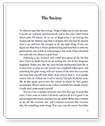Essay Instructions: Write an essay in which you discuss the main points of this article and then agree/disagree with each. Agreeing/disagreeing will entail bringing in your own analysis of the work in question. This is not an either/ or issue though. You may agree with some points the author makes and not with others. But discuss WHY you agree or disagree and support your ideas with analysis and quotes from the text.
1. In the introduction, give us a brief overview of the article itself ? what it focuses on, its general orientation, position and point of view. Then, in a clear thesis, state whether you agree/disagree and why.
2. Take each major point of the article one by one and state what it is, summarize it, including how the author supports his/her points and then discuss your views of it. Do you agree/disagree and in either case why do you? Develop your arguments with in-depth explanation and examples/quotes from the original story.
Title: Hemingway's Hills Like White Elephants
Author(s): Paul Rankin
Source: The Explicator. 63.4 (Summer 2005): p234. From Literature Resource Center.
Document Type: Critical essay
Bookmark: Bookmark this Document
Although it would overstate the matter to suggest that a single critical consensus exists regarding the resolution of Ernest Hemingway's "Hills Like White Elephants," a summation of the majority opinion might produce something along these lines: in an impressive feat of dialogue-driven narrative prose, Hemingway's unnamed American male protagonist dominates the meeker, weaker-sexed Jig--the other in terms of her femaleness, her youth (she is the girl as opposed to the woman who tends bar), and her foreignness (because he receives the specific national identification, we may deduce that it's meant to distinguish his from hers)--until, broken, she submits to his will and consents to aborting the child. Frederick Busch phrases it most succinctly when he argues that Jig "buries her way of seeing as she will bury her child" (762). Other critics have suggested that "the male's language [of distance and control] overpowers [Jig]" (O'Brien 22-23) and that "Jig [...] knows that she will never bear the child she is carrying" (Abdoo 238). A closer look at what Janet Burroway refers to as the pattern of shifting power, however, reveals a more subversive current in the dialogue--one in which Jig, the xenofeminine, outwits her boorish American inamorato and manipulates both the conversation and the man at each turn to control the shared destiny of her and the unborn child (36). Read according to this pattern of subversion, the story emerges as a series of parries that demonstrate Jig's superiority in terms of her cognitive and conative intelligence, as well as her experience, her scathing wit, and her facility with ironic sarcasm, all of which culminate in the absolute straightforwardness of the last line, a line that incidentally coincides with Jig's own dramatic epiphany: There's nothing wrong with me. I feel fine.
In the economies of such notable theorists as Carl Gustav Jung and Karen Horney, the man's attempt to bully pregnant Jig, although certainly by no means justified, should come as no surprise. We need look no further than Jung's valuation of the mother "for whose sake everything that embraces, protects, nourishes, and helps assumes maternal form" (qtd. in Wilmer 40) to begin to comprehend the nature of the man's feelings of inadequacy and inferiority in the face of Jig's imminent transformation from "the girl" into motherhood. Horney goes Jung one step further, contending that man's fundamental lack of "life-creating power," with which woman is imbued, has motivated the creation of such historically masculine enterprises as "[s]tate, religion, art, and science" in man's attempt to compensate for that insurmountable deficiency (366-67). Unfortunately, however, "even the greatest [...] achievements [...] cannot fully make up for something for which we are not endowed by nature" (Horney 367). Thus we may expect to encounter, in extreme cases, such attitudes as the man's in "Hills," whose "notion of behaving 'reasonably'" cannot include "birth of any sort" (Busch 761).
As the man persists in opposing the continuance of Jig's maternity, he grossly oversimplifies the issue, even to the point of self-contradiction, calling the abortion first "an awfully simple operation," and then "not really an operation at all" (212). Here and elsewhere, the excessive modifiers like "awfully" and "really" indicate the man's awareness that this will not be an easy sale and belie his understanding, whether he would be willing to acknowledge this or not, of Jig's formidable intelligence and will. We perceive these attributes directly from Jig as well, as she demonstrates an increasing awareness not only of the gravity of the situation, but also of the man's self-centered and insecure motivation for pursuing the abortion. Consider, for example how Jig initiates the story's action by asking what they should drink, and also makes the first significant observation in the story, noting that the hills "look like white elephants" (211). At first glance, these details may appear unimportant in the context of the decision they are at odds over, but in a relationship where "all [they] do [is ...] look at things and try new drinks," these particular activities carry a substantial amount of weight. By way of contrast, the man's first three lines are entirely reactionary and essentially passive in nature. To Jig's question about drinks, he replies, "It's pretty hot" (when we have already learned in the opening paragraph that "It was very hot"); to her follow-up suggestion that they drink beer, he calls out, "two beers"; and to the bartender's question "Big ones?" he assents, "Yes. Two big ones" (211). At least initially, the man has nothing to offer, nothing to contribute to the story, just as he has nothing more to contribute to Jig's pregnancy now that he has invested his "minute share in creating new life" (Horney 367).
We encounter further evidence of the man's inferiority complex in his severe response to Jig's playful banter about the similarity between hills and elephants. Having already admitted that he has never seen white elephants, the man angrily berates Jig, saying, "Just because you say I wouldn't have doesn't prove anything" (211). In a story of exchanges, Jig's reaction here speaks volumes--she makes another observation and changes the subject. Jig's ability to take in her surroundings and find ways to diffuse the man's anger demonstrates her resourcefulness at the same time it raises the problematic question that drives the story: Is Jig merely ceding her will to the superior and dominant male's, or is she, rather, manipulating him (and the situation as a whole) to her advantage by giving him the illusion of the upper hand?
To answer this question, we must look backward and forward in the story and put this particular exchange in context. Our backward glance reveals that what set the man off was Jig's access to knowledge and experience that the man cannot have, the first-hand knowledge of what white elephants look like. Recognizing this truth as well as the bamboo curtain, Jig shifts the focus from something she knows that the man does not to something he knows that she does not. Even that ignorance of Anis del Toro, however, appears questionable when we arrive at the manifest sarcasm of her response to his blithe observation that "that's the way with everything," to which she replies, "Especially all the things you've waited so long for, like absinthe." Her awareness of the drink's composition indicates that she knew more than she let on when she inquired about the curtain, and thus we can conclude that something other than curiosity or ignorance motivated her question. Thus, we see Jig powerfully asserting her will, and doing so in such a way that she averts unnecessary confrontation several paragraphs before we encounter the discussion of the "operation."
As we do come to that discussion, as the confrontation becomes entirely necessary, the flurry of verbal punches only serves to intensify Jig's resistance as she grows more explicit in her refusal. "No, we can't," she repeats several times, ironically refuting his assent to her own sarcastic declaration that "we could have everything." Demonstrating his now-characteristic inability to understand her point of view, the man assumes that she is still referring to "the whole world" when she says, "It isn't ours any more." Still subversive, still subtle even as the exchange heats up, Jig corrects him once and for all, saying, "No it isn't. And once they take it away, you never get it back." When the man acknowledges that "they haven't taken it away" yet, perhaps without even realizing it, perhaps still imagining she means the world (and all it has come to signify in terms of their unfettered experience and his selfish desire to hang on to that), he proves Jig's point and effectively closes off any further negotiation (213).
What remains is primarily denouement, where the man and Jig return to their drinks and wait for the train. As he attempts to broach the subject, the girl shuts him down completely, and even though the point of view follows him as he passes through the bar, drinks more Anis, and returns, ultimately, Jig gets the last word: "There's nothing wrong with me" (214). The man has heretofore treated Jig's pregnancy like a burden or an illness, whereas Jig, in the cross-talk that emerges from the "no-we-can't" volley, equates the pregnancy, and by implication the child, with "the whole world."
In the final analysis, contenders on either side of the debate must acknowledge that, much like Frank Stockton's "The Lady or the Tiger," this story leaves us at the brink of enlightenment. Unlike Stockton's resolution, which hinges solely on the whims of chance, Hemingway has endowed us with sufficient elements of characterization--Jig's wit, resourcefulness, and strong will as opposed to the man's quick temper, self-centeredness, and irresponsibility--to make an educated guess as to the direction of their immediate future. In a story built on irony and sarcasm, it is almost paradoxical how sincere Jig's final declaration reads: "There's nothing wrong with me," she says, and we understand finally that the white elephant was never the abortion or even the unborn child itself--it was always the man.
--PAUL RANKIN, Hinds Community College
WORKS CITED
Abdoo, Sherlyn. "Hemingway's Hills Like White Elephants." Explicator 49.4 (1991): 238-40.
Burroway, Janet. Writing Fiction: A Guide to Narrative Craft. 6th ed. New York: Longman, 2003.
Busch, Frederick. "On Hills Like White Elephants." Norton Anthology of Short Fiction. Ed. R. V. Cassill et al. 6th ed. New York: Norton, 2000, 761-62.
Hemingway, Ernest. "Hills Like White Elephants." The Complete Short Stories of Ernest Hemingway. New York: Collier, 1987, 211-14.
Horney, Karen. "The Distrust Between the Sexes." A World of Ideas. Ed. Lee A. Jacobus. 6th ed. Boston: Bedford/St. Martin's. 2002. 357-71.
O'Brien, Timothy D. "Allusion, World-Play, and the Central Conflict in Hemingway's 'Hills Like White Elephants.'" Hemingway Review 12.1 (1992): 19-26.
Stockton, Frank. "The Lady or the Tiger." 1882. Short Stories at East of the Web. 2003. Hyperfiction. 3 August 2005. .
The Lady or the Tiger and Other Stories. New York: Garrett Press, 1969.
Wilmer, Harry A. Practical Jung: Nuts and Bolts of Jungian Psychotherapy. Wilmette, IL: Chiron, 1987.
Rankin, Paul
Source Citation
Rankin, Paul. "Hemingway's Hills Like White Elephants." The Explicator 63.4 (2005): 234+. Literature Resource Center. Web. 17 May 2011.
Document URL
http://0-go.galegroup.com.library.wvmccd.cc.ca.us/ps/i.do?&id=GALE%7CA&v=2.1&u=mission_main&it=r&p=LitRC&sw=w
Gale Document Number: GALE##A


